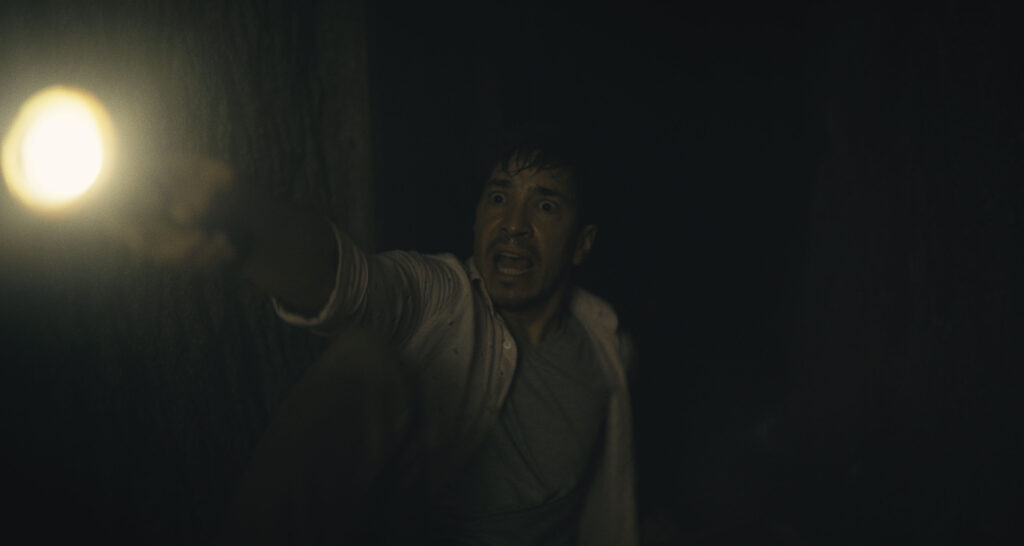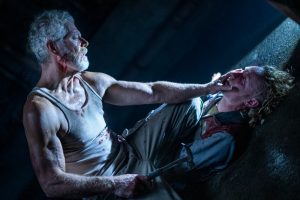July 1, 2023
by Carla Hay

Directed by Peter Nicks
Culture Representation: Taking place in 2020, in various parts of the United States, the documentary film “Anthem” features a racially diverse group of people (African American, white, Latino, Native American and a few Asians) who are connected in some way to the documentary’s mission to find a variety of American residents to create a new U.S. national anthem.
Culture Clash: People disagree on what “patriotic” music and lyrics are supposed to be for Americans.
Culture Audience: “Anthem” will appeal primarily to viewers who are fans of the documentary’s stars Kris Bowers and DJ Dahi, as well as fans of documentaries about racially diverse people joining together for a common cause, but this movie bites off more than it can chew on this weighty subject matter.

Although “Anthem” might have had good intentions to do something groundbreaking in music and American culture, it really looks like a half-baked experiment and an excuse to take a road trip. This documentary is supposed to be about a diverse group of people creating a new U.S. national anthem, but people of Asian heritage are mostly excluded from this movie. It’s a travelogue and a long commercial for the song that’s performed at the end. And that song? After all the buildup and hype in this documentary, the song that the group comes up with—”We Are America”—is really just a bland and forgettable pop tune. There’s nothing iconic about this song at all.
Directed by Peter Nicks (who is seen briefly in the movie), “Anthem” (which had its premiere at the 2023 Tribeca Festival) looks like the type of movie that seems like a great idea on paper. But the complexities involved in doing this concept justice just seemed to be too much for this documentary’s filmmakers. There’s a lot of footage of film/TV composer Kris Bowers (“King Richard,” “Bridgerton”) and hip-hop artist DJ Dahi on a road trip to six metropolitan areas of the U.S., where they spend a lot of time sitting in on local band rehearsals and nodding along to whatever the people are saying in the interviews.
It’s explained in the movie, when Bowers and DJ Dahi meet in Los Angeles, that these two artists didn’t know each other before the road trip. Bowers and DJ Dahi (whose real name is Dacoury Dahi Natche) have amiable chemistry together, but this documentary would have been more interesting if the two taking the road trip were music artists who know each other very well. Bowers (who is one of the producers of “Anthem”) and DJ Dahi are also quite passive in their conversations with the local music artists. The questions they ask are often boring and needed more curiosity and charisma, if the intent was to recruit these singers and musicians to be in the group that’s writing and performing this “new national anthem.”
The documentary explains that this “new national anthem” is not intended to replace “The Star-Spangled Banner.” It is intended to be a more updated national anthem that is a better reflection of how much more diverse the United States is in the 2020s, compared to when Francis Scott Key wrote the lyrics to “The Star-Spangled Banner” in 1814. The inherent problem, of course, is that with so many more music genres that didn’t exist in 1814 but were invented in the 20th century (including rock, hip-hop and electronic dance music, to name a few), it’s impossibe to come up with a new song that everyone in America can agree is the best representation of America.
Various cultural experts such as Nikole Hannah-Jones, Shana L. Redmond and Mark Clague weigh on what it means to even think about creating a new national anthem. They all say the obvious: Some people will think it’s an inspired idea, while others will think it’s highly unpatriotic. For many people in America, “The Star-Spangled Banner” represents freedom. For other, people “The Star-Spangled Banner” represents oppression.
Redmond comments that any deviation or different version of the U.S. national anthem is “seen as an affront.” It’s also noted in the documentary that people of color who perform different musical arrangements of the national anthem tend to get the harshest criticism. Jimi Hendrix and José Feliciano are mentioned as examples of how their versions of “The Star-Spangled Banner” got a lot of backlash when Hendrix and Feliciano first performed these versions in the late 1960s.
Considering how vast the United States is, in terms of land space, Bowers and DJ Dahi realistically could not go to every major city if the documentary had time constraints. However, going to only six regions—Detroit; Clarksdale, Mississippi; Nashville; New Orleans; Oklahoma; and the San Francisco Bay Area—still seems a bit skimpy, considering that only one of these regions (the San Francisco Bay Area) is not in the South or Midwest. In each region, Bowers and DJ Dahi visit with local musicians to get their thoughts on music and possibly recruit some of these musicians to be a part of the making of this “new national anthem.”
For this documentary, Detroit was chosen to represent R&B music in America; Clarksdale was chosen to represent blues music in America; Nashville was chosen to represent country music in America; Oklahoma was chosen to represent Native American music; and the San Francisco Bay Area was chosen to represent Latin music in America. For unknown reasons, “Anthem” ignores cities and spotlights for rock and hip-hop, two of the most important American-made music genres. And it’s a baffling omission, considering that DJ Dahi is a hip-hop producer who has worked with hip-hop artists such as Kendrick Lamar, Travis Scott and Drake.
The interviews range from generic to fairly insightful. In Detroit, keyboardist Joseph “Amp” Fiddler comments: “We love this country. We love the people in our country. But does our country love us?” In Clarksdale, harmonica player Terry “Harmonica” Bean says about the blues: “The music that you hear from here, America gets the credit for it, but it comes from Africa … The blues will never die. We’re just passing it on, passing the torch.”
Discussions of “The Star-Spangled Banner” also extend to perceptions of the American flag and its offshoots. In Clarksdale, singer/keyboardist Eden Brent reflects on how she, as a white woman living the U.S. South, changed her mind about the Confederate flag over time when she learned how many people see the Confederate flag as a symbol of racism. She says that even though some people might defend the Confederate flag as being a symbol of “Southern pride,” people shouldn’t forget that the history of the Confederate flag was about fighting to keep slavery legal in the United States.
In the San Francisco Bay Area, self-described radical activist musician Cecilia Peña-Govea (whose stage name is La Doña) openly talks about how the U.S. flag has become a symbol of greed and destruction for her. In Nashville, singer Charity Bowden says the U.S. flag and “The Star-Spangled Banner” will always be a source of pride for her, especially since she comes from a military family. It’s at this point in the movie that you know the filmmakers are going to be like reality TV producers and have Peña-Govea and Bowden working in a room together, and the two women inevitably clash with each other. And sure enough, that happens. By contrast, one of the artist highlights of the documentary is seeing poet Joy Harjo show her entrancing talent in the recording studio.
With all this talk of diversity throughout “Anthem,” there is surprisingly very little representation of people with Asian heritage in the documentary’s selection of musicians and singers who get the spotlight. In New Orleans, trombonist Haruka Kakuchi is shown briefly with the Preservation Hall Jazz Band. Singer-songwriter Thao Nguyen is seen playing “We Are America” during the movie’s end credits. People of South Asian heritage are excluded in this movie, in terms of the prominently featured musicians and singers.
Other people featured in the documentary include lighting director Briana Nicole Henry and the following music artists: Larae Starr, Dennis Coffey, Paul Randolph, Anthony “Big A” Sherrod, Lee Williams, Ruby Amanfu, Jack Schneider, Zachariah Akil Witcher, Ellen Angelico, Megan Brittany Coleman, Preston James, Glen Finister Andrews, Charlie Gabriel, Wendell Brunious, Richard Moten, George Coser, Dana Tiger, Watko Long, Miguel Govea, Naomi Garcia Pasmanick, Sergio Duran and Esai Moreno Salas. The credited songwriters for “We Are America” are Amanfu, Bowden, Bowers, Peña-Govea, Harjo and DJ Dahi, under his real name.
Although the technical aspects of “Anthem” are well-done, the documentary doesn’t look like a fascinating history lesson that blends music and American history. Instead, the documentary looks like a hastily assembled hodgepodge of people brought together to write and record a “music by committee” song that, frankly, does not sound all that majestic and is very underwhelming for a so-called “national anthem.” Regardless of what your definiton is of “patriotism,” or what you think about the United States, “Anthem” is a documentary that falls very short of its intention to be a trailblazing project.
Hulu premiered “Anthem” on June 28, 2023.






